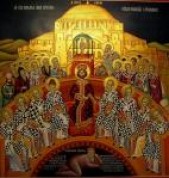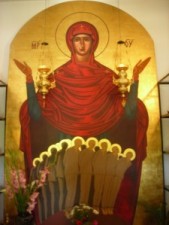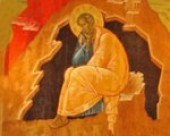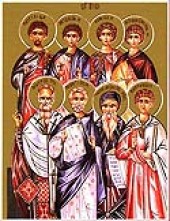Holy Great Martyr Demetrius (Dimitri) of Thessalonica
Commemorated October 26 (Nov. 8th by civil calendar)
(Life taken from the Prologue of Ohrid)
.jpg)
This glorious and wonderworking saint was born in Thessalonica of noble and devout parents. Implored of God by childless parents, Demetrius was their only son, and so was raised and educated with great care. Demetrius’s father was a commander in Thessalonica. When his father died, Emperor Maximian appointed Demetrius as commander in his place. As he appointed him, Maximian, an opponent of Christ, particularly recommended that he persecute and exterminate the Christians in Thessalonica. Demetrius not only disobeyed the emperor but openly confessed and preached the Lord Jesus Christ in the city of Thessalonica. When the emperor heard of this he became furious with Demetrius. Then, when he was returning from battle against the Sarmatians, Maximian stopped at Thessalonica to investigate the matter. The emperor summoned Demetrius and questioned him about his faith. Demetrius openly acknowledged his Christian Faith to the emperor and also denounced the emperor’s idolatry. Maximian cast Demetrius into prison. Knowing what was awaiting him, Demetrius gave all his goods to his faithful servant Lupus to distribute to the poor, and joyfully awaited his imminent suffering for Christ the Lord. An angel of God appeared to him in prison, saying: “Peace be to you, O sufferer of Christ; be brave and be strong!” After several days, the emperor sent soldiers to the prison to kill Demetrius. The soldiers found the saint of God at prayer and ran him through with lances [in 306 A.D.]. Christians secretly took his body and honorably buried it. Healing myrrh flowed from the body of the martyr of Christ, curing many of the sick. Soon, a small church was built over his relics.
An Illyrian nobleman, Leontius, was afflicted with an incurable illness. He hastened, with prayer, to the relics of St. Demetrius and was completely healed. In thanksgiving, Leontius erected a much larger church on the site of the old church. The saint appeared to him on two occasions. When Emperor Justinian wanted to translate the relics of the saint from Thessalonica to Constantinople, flaming sparks sprang from the tomb and a voice was heard: “Stop, and do not touch!” And thus, the relics of St. Demetrius have remained for all time in Thessalonica. As the protector of Thessalonica, St. Demetrius has appeared many times, and on many occasions has saved Thessalonica from great calamity. His miracles are without number. The Russians considered St. Demetrius to be the protector of Siberia, which was conquered and annexed to Russia on October 26, 1581.
The Church of St. Demetrios the Great Martyr from Thessalonica
The Church of St. Demetrius the Great Martyr, also known as “the Mirth streaming ‘, is an Orthodox church in Thessalonica, Greece. The Church dedicated to the patron saint of the city: St. Demetrius, dates from the period when Thessalonica was the second largest city of the Byzantine Empire.

The city of Thessalonica, the second largest city in Greece and the principal city of ancient region of Macedonia, was the capital of one of the four Roman districts of Macedonia. The name of this city comes from the wife of Cassander and sister of Alexander the Great – the one who founded the city.
.jpg)
The Christian Community of Thessalonica was founded by St. Paul during his second missionary journey, when he preached in the jewish synagogue of this city.
The everyday life of these Christian communities, as presented by the Apostle Paul in his second epistle to the Thessalonians, can be considered a model, because the life and ministry of the citizens of Thessalonica determined St. Paul’s to always give thanks to God our Lord for them. “We always praise/thank God for all of you, as we remember you in our prayers.” (Thessalonians 1, 2)
.jpg)
St. Demetrios Church is one of the main attractions of the city of Thessalonica, many pilgrims come here to venerate the mirth-streaming relics of St. Demetrios the Great Martyr. The church also belongs to the paleo-Christian and Byzantine Monuments of Thessalonica, being part of UNESCO World Heritage since 1988.
.jpg)
The first church was built on this site in the early fourth century, shortly after the year 313, replacing an existing Roman bath in that area. A century later, a prefect called Leontios, replaced the small church with a much larger one, a basilica with three apses.
The initial Church was destroyed by fire in several occasions and was restored later, (between 629 and 634) into a basilica with five apses. This church, almost identical to that which we see today will quickly become the most important place of worship in the city.
.jpg)
Inside the church , a structure called “ciborium” holds the holy relics of St Demetrios.
.jpg)
The Basilica of St. Demetrius the Great Martyr is famous for its Byzantine art/mosaics and iconography, dating from the last rebuilding of the church to the iconoclastic period of 730.
.jpg)
A mural mosaic depicting St. Demetrius, with those involved in the restoration of the church, is a rare one preserved in the period that followed the sad memory of the death of the Byzantine Emperor Justinian. One of the inscriptions found in the mosaics, gives glory to God for the deliverance from the attacks by the pagan, in the year 612.
.jpg)
The rest of the mosaics that adorn the interior of the church have disappeared during the four centuries when the building functioned as a mosque (1493-1912), or during the great fire of 1917, which, along with roof and upper walls, destroyed a large part of the building. There are a number of black and white photographs that show the value of this priceless Byzantine monument that was destroyed after the great fire.
.jpg)
The full restoration of the church was completed only in 1949. The Church retains an underground crypt, where according to the tradition, the martyrdom of St Demetrios took place.
.jpg)
The excavations have also revealed the ruins of a Roman bath, where it is believed that the Holy Great Martyr Demetrios was imprisoned and, later, executed by the Roman soldiers, and an ancient fountain where, it is believed that the soldiers discarded the body of martyr Demetrius.
.jpg)
The tomb of St. Demetrios is considered an archaeological site since 1918, when it was discovered. Between 1985-1988, a series of excavations took place in the northern part, thus restoring one other part of the tomb.
.jpg)
The Holy Great Martyr Demetrios (the Myrrh Streaming) is commemorated on the 26 of October.
Through the prayers of the Holy Great Martyr Demetrios, Lord Jesus Christ have mercy on us. Amen!

 Christian Dogma
Christian Dogma Christian Martyrs
Christian Martyrs Christian Orthodox Churches and Monasteries
Christian Orthodox Churches and Monasteries Christian Sermons and News
Christian Sermons and News Church's Teachings on Fasting
Church's Teachings on Fasting Ecumenism – a Great Heresy
Ecumenism – a Great Heresy Father George Calciu
Father George Calciu Life_a Sacred Gift form God
Life_a Sacred Gift form God Orthodox Saints and Church Fathers
Orthodox Saints and Church Fathers Spiritual Elders
Spiritual Elders Daily Bible Readings
Daily Bible Readings Journey to Orthodoxy
Journey to Orthodoxy Listen to Ancient Faith Radio
Listen to Ancient Faith Radio Orthodox Calendar of Feasts and Saints
Orthodox Calendar of Feasts and Saints Orthodox Christian Mission Center
Orthodox Christian Mission Center Orthodox Institute
Orthodox Institute OrthodoxChristianNetwork TV
OrthodoxChristianNetwork TV
1 comment
Comments feed for this article
September 27, 2014 at 1:09 PM
Please Pray for the Church in Greece - Mere Comments
[…] of Islam in Thessaloniki. We have already lost so much… When the Turkish minister entered the Church of Holy Great Martyr Demetrius of Thessaloniki in our city, he announced at once: ‘Here is a suitable mosque for […]